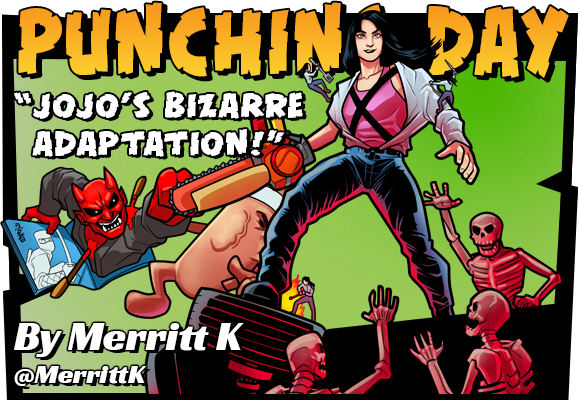
In the 1990s, anime was a mere rumor whispered of in the basements of hobby shops. Past the Magic cards and pogs lay a secret, semi-forbidden world of “Japanimation” or animé, a realm of animation beyond what our minds reared on the thin gruel of Real Monsters and Dougs could possibly conceive. It’s hard to imagine, if all you’ve ever known is a world in which it’s considered perfectly acceptable for, say, a high-powered businesswoman or a busy househusband to proclaim their love for a bosomy anime protagonist, but there was a time when anime was more or less underground in these United States — quite literally, in the case of the aforementioned anime basement that was whispered of at my school in the same hushed tones as the copy of Wild Things that someone’s divorced father let them rent from the video store. Seriously, they used to run ads on late-night TV with the tagline “This ain’t no Mickey Mouse!”

Anime had a mysterious allure to it in those days, and not just because it was hard to access. Putting aside the Pokemons and Sailors Moon which trickled over to Western channels, it was widely understood that anime was grown up stuff — the domain of older brothers with subscriptions to Wizard Magazine who were almost old enough to grow facial hair. Rumors circulated around the playground about Japanese cartoons where people got cut in half, where naked breasts were on full display, and where tentacles quested into orifices traditionally considered the preserve of married heterosexual couples.

This is the context in which comic artist Joe Weltjens first discovered the manga-turned anime called JoJo’s Bizarre Adventure. Coming across a fan-subtitled videotape, as was the style at the time, Weltjens’ encounter with the beautiful creation of Hirohiko Araki would blossom into that most sincere form of flattery, imitation, after he attempted and failed to get the rights to bring the series to the west. “To hell with it,” Weltjens must have thought, “I’ll make my own anime! With Star Wars references! And I’ll call it Diesel, after the most popular brand of jeans on the market today, in 1997!”
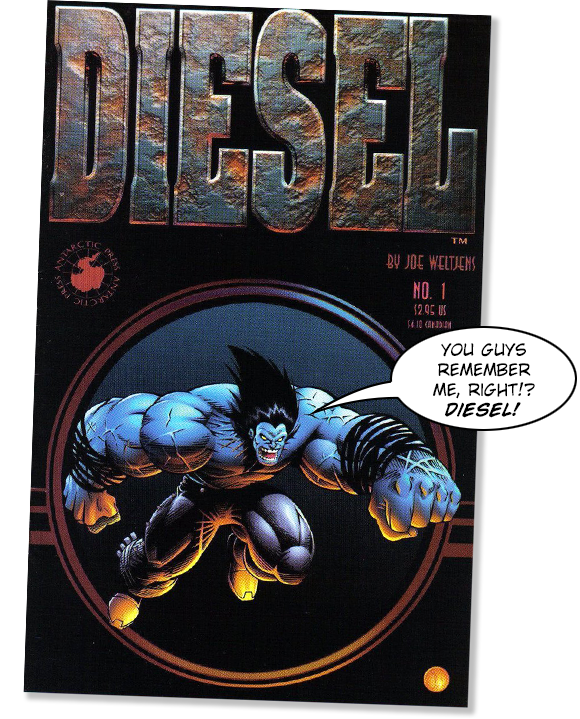
For the uninitiated, JoJo’s Bizarre Adventure is a manga series that’s been running more or less continuously since 1987. Trying to describe the plot is sort of a challenge, but here’s my best shot: it’s about a Victorian orphan with daddy issues named after metal legend Ronnie James Dio becoming the world’s sexiest gay vampire thanks to an ancient Aztec mask and taking revenge on his adoptive family in various ways over the course of several decades. The series takes its name from the protagonist of the first part: Jonathan Joestar. From then on, every protagonist had a name that followed the same scheme: JOseph JOestar, JOtaro KuJO, and so on.
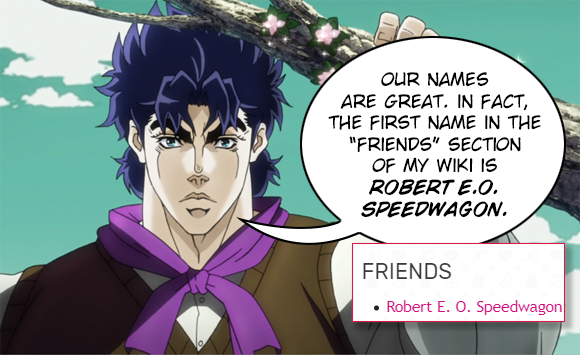
JoJo started out as a pretty typical action-adventure story, with a serious and noble protagonist learning mystical martial arts secrets from a flamboyant Italian man and using them to harmlessly punch frogs, but Araki eventually realized that his true passions were prog rock and making his increasingly slutty, twinky lead characters dress in more and more absurd couture, have child-like arguments about the interactions between their superpowers, and drink piss.
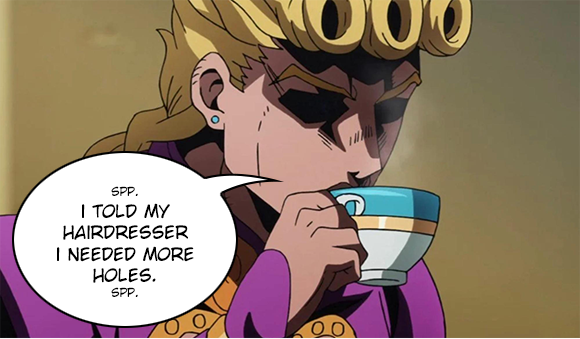
So what does Joe Weltjens’ Diesel take from all that? Well, not much. Basically all it borrows is the core concept of “Stands.” In JoJo, Stands are weaponized tulpas. They’re called Stands because they “stand” beside you, except for all of the many, many instances in which they don’t because they’re your hair, a sword, or an entire cruise liner. The prototypical Stand is a humanoid figure that engages in fighting on the part of the character who wields it, making them basically a means of showing fights with superpowers in more interesting ways than characters just shooting lasers out of their eyes or whatever.
You can’t really blame Weltjens for that, though. The single issue of Diesel he produced adapts an encounter from late in the third part of JoJo called Stardust Crusaders, the only part of the manga that had been committed to animation in the ’90s and thus probably all that he had exposure to back then. While things do start to get weird in part three as Araki starts to explore the themes he would build on throughout the series — there’s an extended magical fight between a dog and a bird, a man named Vanilla Ice cuts off his own head, two of the protagonists get their dicks stuck together with magnets, and so on — it’s still in many ways a pretty straightforward adventure story.
Anyway, Diesel opens on an enormous, gaudy mansion complete with golden fountains spraying water into an oddly photorealistic-looking pool that seems to clash with the rest of the art. You can really feel the frustration in this mess. It’s how a hungover freshman would just barely not get an F in a mixed media class. It might as well say, “Whatever. Drawing fountains fucking sucks.”
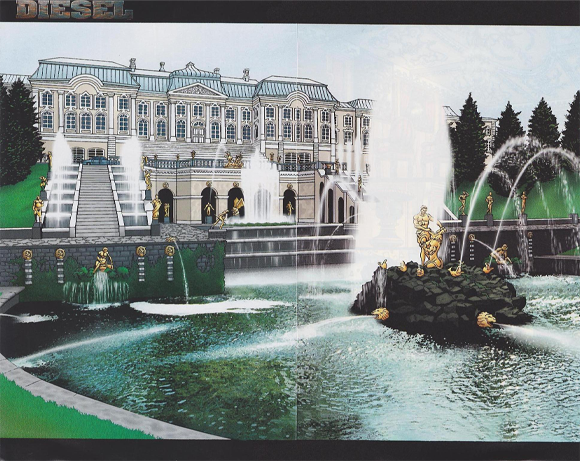
Inside the mansion, a man named Mr. Botha (deez nuts) sits at the end of a preposterously long table drinking wine like Dracula when suddenly, a gigantic monster that looks like the love child of the Hulk and a Dragon Ball Z character bursts through the door, killing two goons and swiftly dematerializing behind its Stand user. This is the introduction of our protagonist, Tom Diesel — yes, Thomas Diesel is his god-given name — and his Stand, “Meta Hammer.”
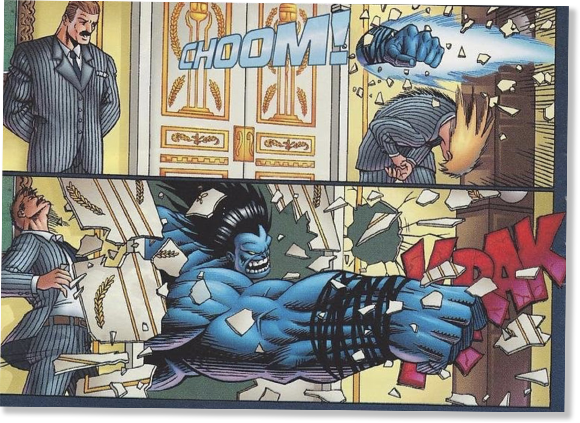
And sure, having your lead character bust into the villain’s lair and effortlessly dispatch his henchmen is a decent way of getting the reader to think he’s a real cool guy, but can we talk about his character design? Tom Diesel looks like a loaf of Wonder Bread was granted his wish to be a man.
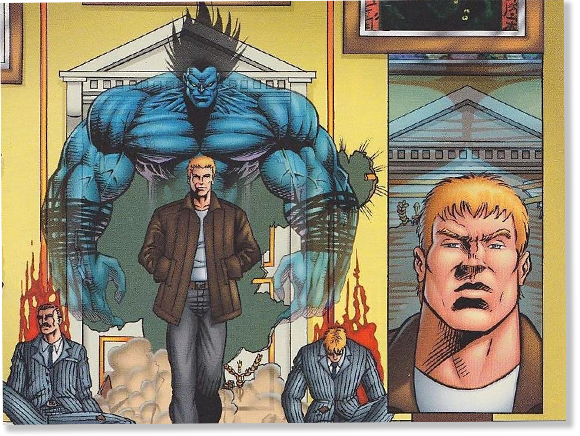
He’s literally a nondescript blonde white guy wearing a t-shirt, pants, and a featureless jacket. The human eye is incapable of focusing on him, sliding off in search of anything of visual interest to linger on. This man could walk right out of a store with a TV and your statement to the police would be, “Something shapelike took it, it might have had legs.” In contrast, look at the character Tom’s based on in JoJo, Jotaro Kujo.
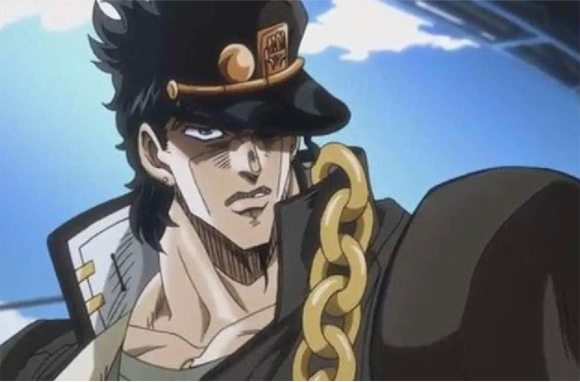
Is his hat part of his hair? Are those chains part of the standard school uniform? Why does he look like a thirty-year-old bodybuilder instead of a 17-year-old high school student? Who knows, but at least his design raises questions, unlike Tom’s.
Ah, but maybe Tom is meant to be pretty plain so the real focus is on his Stand? Again, though, Meta Hammer looks like someone put Vegeta’s hair on the Hulk and changed the color of his skin. Look, I’ll prove it.
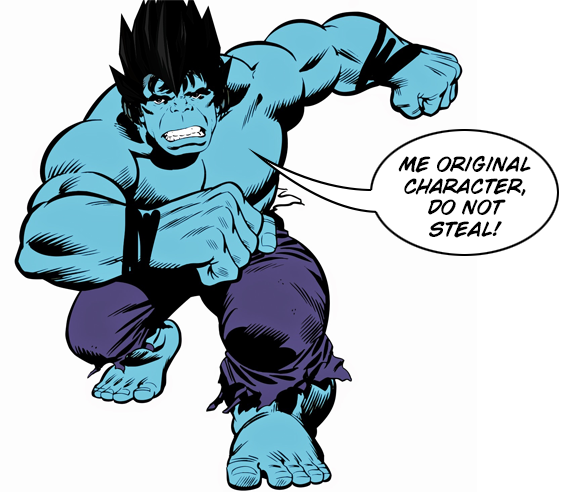
And compare Meta Hammer to Star Platinum, the Stand it’s based on. It’s still just a weird guy at its core, but it at least has some other stuff going on.
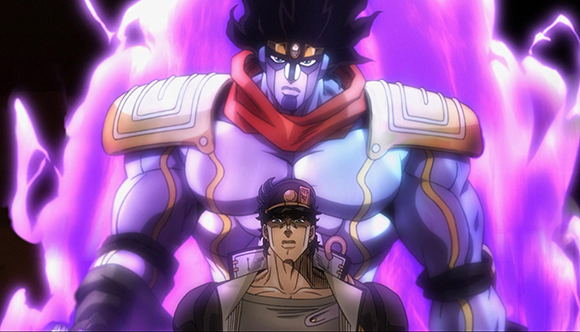
Regardless, as you might expect, Mr. Botha is displeased by the intrusion of the world’s most present white man and his blue ghost warrior, but we’re not going to get any resolution, because we’re immediately thrust back in time three months. We get a flashback between a Mr. Evans and Mr. Botha in which Weltjens temporarily forgets how speech bubbles work.
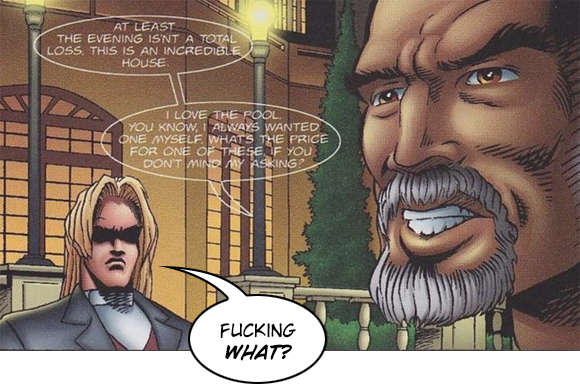
Then Mr. Evans gets cut in half by Mr. Botha’s mysterious powers and lands in the pool with an expression that looks less like one of utter agony and more like an ape watching a card trick.
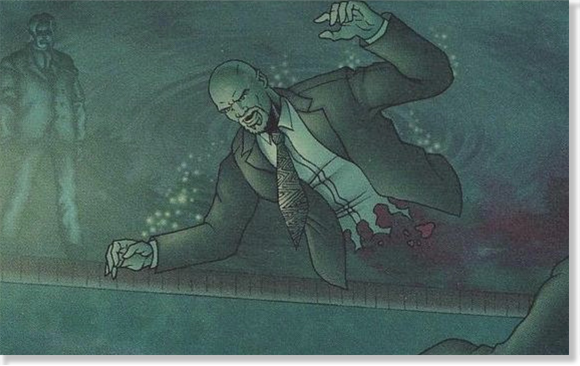
Now we’re in England. Gosh, we’re really just jumping all over time and space, huh? Tom Diesel returns home to see his adoptive sister May and is attacked by an overzealous guy with an electric Stand before she’s able to calm things down with the power of her own Stand, Mrs. Tits.
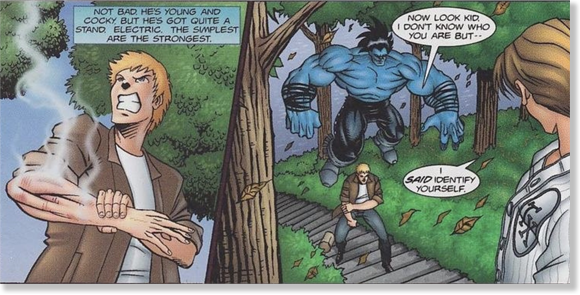
This is a good time to bring up one of the weirdest things about Diesel — the art. It’s all just slightly off in that “How to Draw Japanimation” kind of way. You remember those books you’d find at Borders in the ’90s seemingly put together by a guy who’d seen half an episode of Ranma 1/2? It’s like that, only Weltjens can’t seem to fully commit to the bit. Most of the time, characters’ faces look like Platonic ’90s comics guys — the kind of faces you’d see in a good American book like Bloodstrike or Ultraforce. But every once in a while, they’re struck with Weeb’s Syndrome, a condition which manifests in muscle spasms that radically alter the shape and placement of your facial features. Also they sometimes get little storm clouds over their heads. That’s an anime thing, right? Maybe?
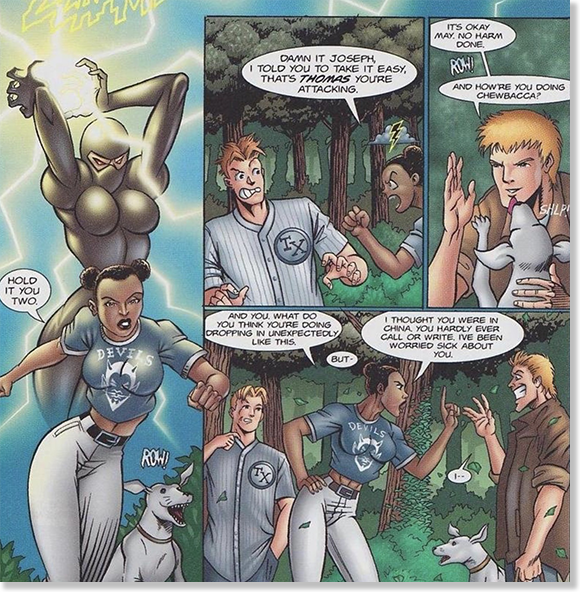
Well, Tom finds out that Mr. Evans was killed by Mr. Botha (deez cheeks) and wants revenge. Before that can happen, though, the gang is attacked by… wait for it… an:
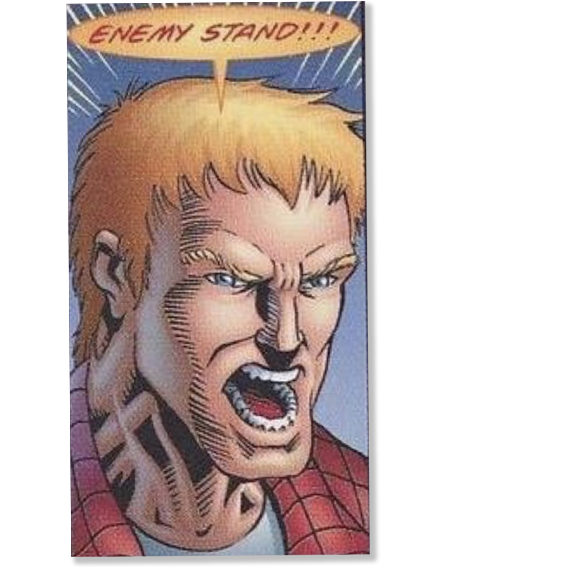
This is probably the most famous panel in Diesel. Tom Diesel’s American-ass face hollering about an enemy Stand perfectly encapsulates the futility of creating an Americanized JoJo. Like the cursed attempts to develop an American Peep Show, it was never meant to be, and transplanting the concepts and terms from their home culture to that of the United States simply makes everyone involved seem like howling maniacs.
That said, the focus on that particular panel has allowed the utter madness surrounding it slip into obscurity. I mean, look at this.
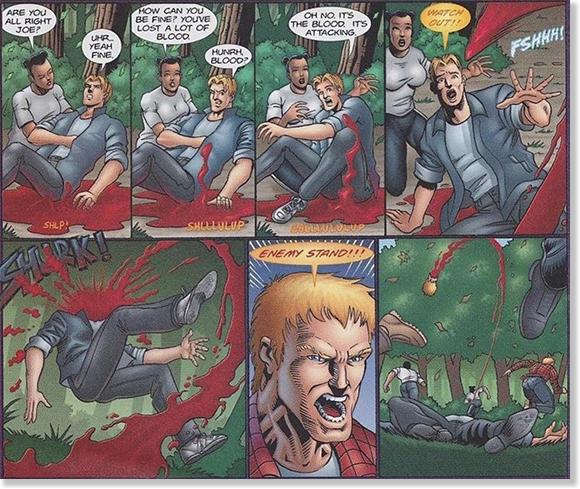
That’s a character getting his head knocked off by animated blood, which then sends his noggin flying in a comical arc before it finally comes to rest next to his corpse. Also, credit where credit’s due: this is a semi-original idea from Weltjens. In the original manga, the gang fights a similar blind Stand user who attacks from a hidden location and tracks via sound, but he controls water rather than blood.
Well, Tom does the big damn hero shtick, sending his friends away so he can take on the enemy mano-a-blue Hulko. He even sort-of flies by having his Stand leap into the air and carry him, making him look like a child getting dragged out of a candy store. This is supposed to be our main character and he looks like an NPC in a game called Hulk League Humanball.
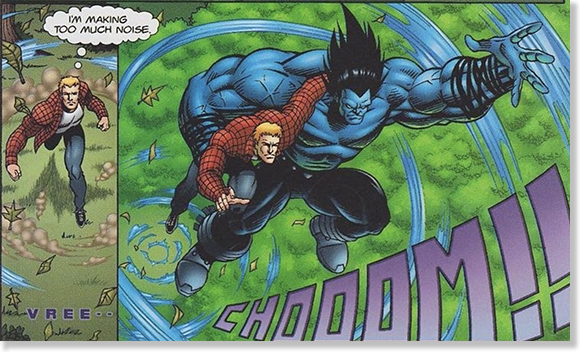
Because the guy is hiding like a dirty blind coward, Tom uses his dog to locate him. And here, I have to admit that Diesel actually gets something right about JoJo — there’s a running joke that Araki has a difficult time drawing dogs, and that, perhaps as a result, he takes his frustration out on them in his narratives whenever he gets the chance. If a dog or other small animal shows up in JoJo, it’s probably about to explode. And sure enough, when Tom sends his dog Chewbacca to root out his enemy in the woods, the dog gets its fucking throat slashed.
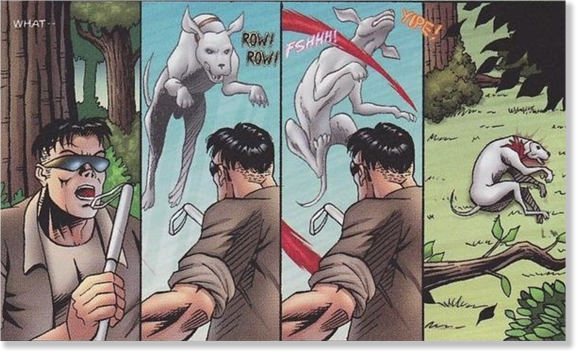
Probably not the kind of detail I’d commit to including in my adaptation, but to be fair I’ve never really had to draw a dog for work before. Maybe it really makes you hate them.
Before Tom can get any information out of his foe, the guy is stabbed by another Stand belonging to a man standing perfectly straight on a tree branch like a really cool dude. He’s named Chibot, I guess, and he tells Tom he’s passed the first test. Presumably the first test was exploding your beloved childhood dog? Or maybe it was having a blind man die in your arms from samurai sword-inflicted wounds. Who knows, and who cares. This is a half-finished knockoff by someone who screwed up every ingredient except the dog murder.
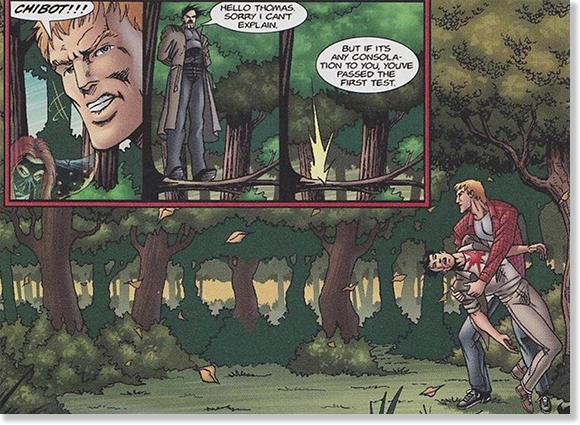
Possibly the funniest detail in this entire comic is that on the very last page where the publisher had the temerity to include the line “No similarity to any character(s) and/or place(s) is intended, and any similarity is purely coincidental.” Of course this is just a boilerplate “don’t sue us” message included in pretty much any work of fiction, but in this case it’s absurd. It’d be like making a comic based on Star Wars, changing the main character’s name to Doug Petrol and giving him a stupid jacket, but still talking about the Force all the time.
And so ends the first and only issue of Diesel, a comic created because an artist couldn’t consummate his love for a Japanese manga and so resorted to satisfaction through his own hand. It’s beautiful, in a way. It was the kind of thing that could only really happen in the late ’90s, in that brief period after anime began to make its way to the west but before it became a mass culture phenomenon, when American teens were just beginning to swoon over bishonen and have arguments about whether Goku or Superman were stronger. (Neither: it’s Mr. Botha. (deez dicks (Mr. Botha has two dicks.)))
One last thing. Throughout all of this, I haven’t mentioned the single weirdest thing about Diesel. We already know the creator is named Joe Weltjens. But “Joe’s” full Christian name is actually Jochen. JOchen “JOe” Weltjens. That’s right: he is, himself, a JoJo, and I wish him luck on whatever bizarre adventure he’s on right now.
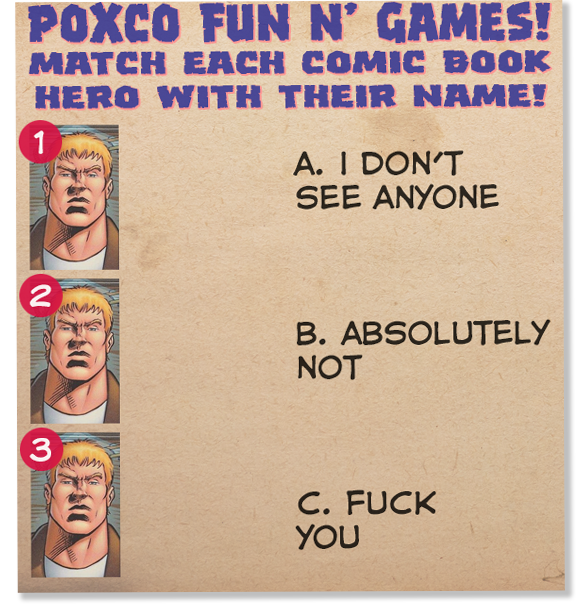
This article was brought to you by our fine sponsor and Hot Dog Supreme: EveryZig, whose stand is Kajagoogoo, a bashful chaise lounge that turns panties into scorpions.

6 replies on “Punching Day: Diesel 🌭”
The mansion is a half-assed tracing of Peterhof Palace, in Russia. He’s not even changed it at all. Guess he plagiarised that too?
This article brought back some wild memories.
Im not a manga or anime guy, but for a period in my early teens everyone was. The first manga film I saw was Legend of the Overfiend. It is 99% tentacle dicks.
The second thing this article made me think of is a long ago 4chan post that mathematically provided superman was infinitely stronger than goku.
Good Times.
Yay. 4chan…
Where’s my whiskey…
Sweet! Found it before I found me gun.
Every kid these days has an anime phase, and each generation has its staple animes. You can probably tell how old someone is just by asking them about which animes they watched as kids and think of fondly as adults. Mine are Sailor Moon and Yu Yu Hakusho, for example.
What’s interesting is that in my experience most people move on. People will watch Miyazaki movies or something like Tokyo Godfathers not because they like anime but because those are critically acclaimed and make it outside the typical Japanophile circle.
It’s only a specific kind of person that stays with anime and usually consumes nothing but manga and anime while thinking everything else is inferior to their Japanese animes.
I remember seeing “Ninja Scroll” for the first time. I was just excited there were cartoons on at one in the morning. I… I… didn’t grow up anymore after that… I just got older.
“animé”
I love the accent. It makes it sound like a fancy french word spoken by a french neckbeard. You know he’s french because he’s feeding a croissant to his dakimakura.
“it was widely understood that anime was grown up stuff”
I never understood this, tbh. I love Cowboy Bebop as much as anyone, but when weeabos argue that anime is inherently superior to western animation and more adult™️ they’re usually talking about some random battle shonen that’s made for the 12-17 year old demographic. Not even seinen or josei. Like, literally cartoons for Japanese kids and teens. Just because the protagonist always falls face-first on his big sister’s mommy milkers or someone vomits an ungodly amount of blood after getting punched doesn’t mean it is adult. That’s a manchild’s idea of mature storytelling.
“Araki eventually realized that his true passions were prog rock and making his increasingly slutty, twinky lead characters dress in more and more absurd couture”
*Twunk protagonists (and futch Jolyne). And the occasional Daddy. Honestly, I confess I could never get fully into the manga and dropped it around the fourth(?) JoJo, but Araki’s art style is fantastic. I think he said he took inspiration from or learned how to draw by using Greek statues as reference? If so, the homoeroticism makes a lot of sense. We, the LGBT community, thank you for your valuable contributions to the world of gay art, Mr. Araki.
“Tom Diesel looks like a loaf of Wonder Bread was granted his wish to be a man.”
Nondescript blond, blue-eyed white man that looks like he might use slurs in front of minorities and tell them to go back to their country is a staple of western comics. Just like the shy teen girl with the huge jugs that can’t string a sentence without saying “protagonist-kun” is an animanga staple. They should date, tbh.
“This is a half-finished knockoff by someone who screwed up every ingredient except the dog murder.”
This reminded me of the fact thst Lionsgate wants to make a live action Naruto, and a chill suddenly ran down my spine.